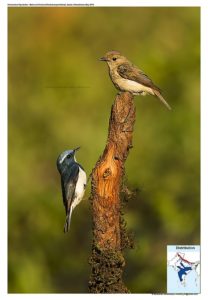Ultramarine Flycatcher

Ultramarine Flycatcher Ficedula superciliaris
Etymology:
- Ficedula : Latin word ficedula –small fig-eating bird
- Superciliaris : Latin word superciliaris – eyebrowed
Vernacular Name: Ass: Nachoni sorai, Lepcha: Tuni-ti-ti, Mar: Nili Mashimar
Distribution in India: Resident of parts of North East India, summer visitor to Himalayas and winter visitor in parts of Central, West and South India.
Description: Size of 11-12 cm, wt. of 8 g. It is a small, compact flycatcher, male deep blue and white. Male of nominate race has short white supercilium from over eye to rear of ear-coverts; rest of head, and upperparts, including upperwing and tail, slate-blue (appearing black in dull light), slightly paler or brighter on crown, blacker on lores to cheek; white patch at side of tail base (often concealed); slate-blue extends down on to side of breast, rest of underparts white; iris dark brown; bill black; legs deep brown with grey, bluish or purplish tinge. Female has greyish-brown upperparts and breast side sometimes complete breast band, underparts otherwise whitish, sometimes a blue or bluish tinge on uppertail-coverts and tail. It flicks or raises tail and fluffs out breast feathers when alarmed. The juvenile has head and upperparts heavily spotted with buffish-white, larger and bolder spots on mantle to rump and scapulars, whitish underparts with dark bars or scaling. The juvenile male has bluish edges on flight-feathers and blue tail, the juvenile female has greyish wings and tail. The first-year male is like female, but with bluish tinge on mantle to uppertail-coverts, wings and tail, also buff tips on greater coverts and whitish fringes on tertials. The races found in India are , Nominate (Central Himalayas; non-breeding at lower altitudes and also Central & South India), race aestigma (Assam, Nagaland, E Meghalaya, Manipur) male has head and upperparts more ultramarine-blue and lacks supercilium and white patch at tail base, female has ashy-grey upperparts tinged browner on forehead to crown and on uppertail-coverts, and ash-grey sides of neck and breast
Habitat:It is found during breeding in broadleaf forest, also in pine forest, between 1800 m and 3200 m. In non-breeding season in open deciduous woodland, groves, orchards, gardens and parks at lower altitudes, down to 150 m.
Food Habits: It eats small invertebrates and larvae. It is usually solitary or in pairs in breeding season; joins mixed-species flocks in wintering areas. It actively forages in middle to upper canopy of forest trees, keeping within foliage and rarely in open; occasionally forages at lower levels and on ground.
Breeding Habits: They breed in Apr-July in India. The nest is built by both sexes. The nest is a cup of moss, bark strips, grass, animal hair and plant fibers, placed in usually well-concealed hole in ivy-covered or creeper-covered tree or bank. It may appropriate nest of smaller bird. They lay a clutch of 3–4 eggs. The incubation is done by both sexes, but mostly by female. The incubating female is fed on nest by male. The incubation period is 12–13 days.